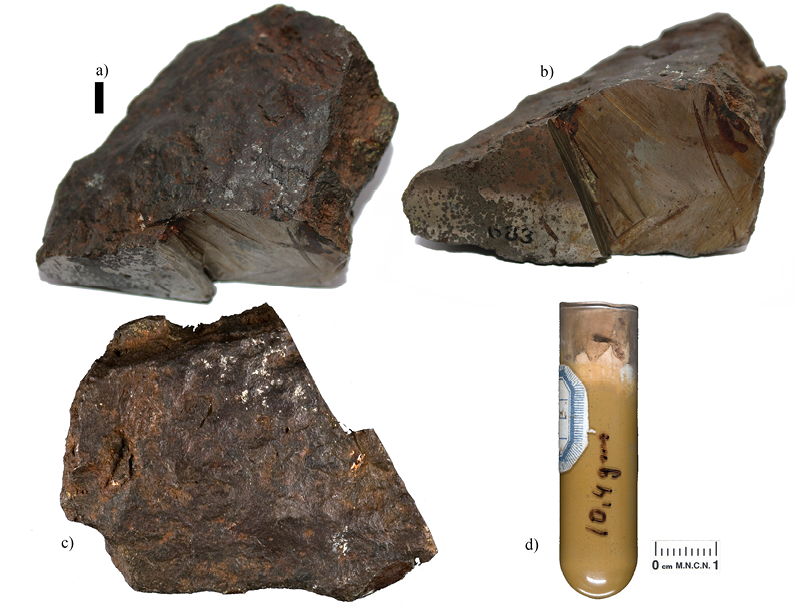
Figure. 1. The Madrid specimen, catalogued as No. 17294. a) Oblique view. b) Lateral view. c) Dorsal view. d) Dust material (10.4 g). Scale = ~1 cm.
How to cite: Ceballos-Izquierdo, Y., Nieto Codina, A., Orihuela, J., 2024, From meteorite to meteor-wrong: Investigating a controversial specimen from Cuba: Revista Mexicana de Ciencias Geológicas, 41(1), 1-10, DOI: 10.22201/cgeo.20072902e.2024.1.1761.
REVISTA MEXICANA DE CIENCIAS GEOLÓGICAS
v. 41, núm. 1, 2024, p. 1-10
DOI: http://dx.doi.org/10.22201/cgeo.20072902e.2024.1.1761
From meteorite to meteor-wrong: Investigating a controversial specimen from Cuba
Yasmani Ceballos-Izquierdo1,*, Aurelio Nieto Codina2 and Johanset Orihuela3
1 Calle 40 #2702, e/27 y 29, Madruga, Mayabeque, Cuba.
2 Museum of Natural Sciences, C/ José Gutiérrez Abascal, 2 28006. Madrid, Spain.
3 Earth and Environment (Geosciences), Florida International University, Miami, Florida, 33199, USA.
* yasmaniceballos@gmail.com
ABSTRACT
The meteorite “Cuba”, whose type of mass is catalogued as MNCN No. 17294 (Museum of Natural Sciences, Madrid, Spain), has long been considered an official meteorite, included in the Meteoritical Society’s online database. However, the provenance and nature of this metallic object remain uncertain due to inconsistencies in its weight, density, hardness, fall location, and chemical composition. This paper argues that this specimen is not a meteorite by examining its chemical and textural properties using modern analytical techniques and by considering alternative explanations for its origin. The application of scanning electron microscopy and energy-dispersive X-ray spectroscopy has helped to confirm the terrestrial nature of the specimen. These results were compared with a specimen supposed to be a meteorite fragment, and with the other two masses labelled as “Cuba” in other museum collections.
Key words: Cuba; iron meteorites; meteorite; SEM-EDS.
RESUMEN
El meteorito “Cuba”, cuya masa tipo está catalogada como MNCN No. 17294 (Museo de Ciencias Naturales, Madrid, España), ha sido considerado durante mucho tiempo un meteorito oficial, incluido en la base de datos en línea de la Sociedad Meteorítica. Sin embargo, la procedencia y naturaleza de este objeto metálico siguen siendo inciertas debido a inconsistencias en su peso, densidad, dureza, ubicación de caída y composición química. Este artículo sostiene que este ejemplar no es un meteorito al examinar sus propiedades químicas y texturales utilizando técnicas analíticas modernas, y considera explicaciones alternativas sobre su origen. La aplicación de microscopía electrónica de barrido y espectroscopía de energía dispersiva de rayos X ayudó a confirmar la naturaleza terrestre de la muestra. Estos resultados se compararon con los obtenidos para una muestra que se supone es un fragmento de meteorito, además de las otras dos masas etiquetadas como “Cuba” en otras colecciones de museos.
Palabras clave: Cuba; meteoritos de hierro; meteorito; SEM-EDS.
Manuscript received: June 29, 2023
Corrected manuscript received: November 9, 2023
Manuscript accepted: November 11, 2023
INTRODUCTION
Iron meteorites, also known as siderites or ferrous meteorites, consist almost entirely of siderophile elements such as nickel and cobalt, which readily dissolve in metallic iron, and chalcophile elements, such as copper and silver (Scott, 2020). Most iron meteorites are thought to be samples of metallic cores and pools formed in diverse tiny planetary bodies (planetesimals), except for the IIE iron meteorite group (Benedix et al., 2014; Scott, 2020). Melting in planetesimals caused dense metals to sink through silicate bodies resulting in the formation of a metallic core. A typical iron meteorite contains ~90 % iron, 5–10 % nickel, ~0.5 % cobalt, 0.1–0.5 % phosphorus, 0.1–1 % sulfur, and over 20 other elements in trace amounts (Krot et al., 2014; Scott, 2020).
Some iron meteorites can be confused with terrestrial rocks or man-made iron objects with features resembling those of true meteorites. After a careful analysis, a specimen initially classified as an iron meteorite may turn out to be a “pseudometeorite” or “meteor-wrong”. These materials include terrestrial metallic iron (i.e., Albina, 2021) and iron oxides such as magnetite, hematite nodules, dark black rocks such as basalt, and many different types of man-made iron by-products such as metallic slags from old smelters and castoff-iron that have corroded over time. Slags often feature very rough, burned, and melted glassy (vitreous) surfaces and vesicles (gas bubbles) created by escaping gases (Senesi et al., 2018). Many slags show flow features in glass, and some have flat surfaces when solidified in a restricted space (Senesi et al., 2018). Quartz in meteorites is uncommon as it is the presence of vesicles (Buchwald, 1977; Senesi et al., 2018). Conversely, when gas escapes during the cooling of a molten material, it creates voids, and cavities on the surface. Thus, if a suspected meteorite is porous or contains vesicles and not regmaglypts, it is likely a terrestrial volcanic rock or slag (Notkin, 2011).
Iron meteorites are significantly denser (7–8 g/cm3) than ordinary Earth rocks (Henderson and Perry, 1954). Additionally, they have a strong magnetic response, as they contain a significant amount of iron-nickel (Fe, Ni) alloys (Scott, 2020). However, many terrestrial rocks and man-made materials are also magnetic, which may result in misleading conclusions. Consequently, precise determination requires adequate laboratory analysis to ascertain the extraterrestrial origin of suspected meteorites, especially iron meteorites (Notkin, 2011). Nickel (Ni) is a rare element on Earth but abundant in meteorites. Therefore, if visual inspection and magnet test are positive, the presence and content of Ni should be investigated, together with that of other diagnostic trace elements such as Ga, Ge, and Ir.
Recently, Ceballos-Izquierdo et al. (2021) reviewed the meteorite and bright fireball records from Cuba, and listed two official meteorites (Cuba, Viñales) and three unofficial records that require official classification (Las Canas, Lajas, and Ramón de las Yaguas). Some rocks (Mango Jobo, Boyeros, Güira de Melena, and Balcón de la Lisa), traditionally identified as iron and/or stony-iron meteorites, were recognized as meteor-wrongs in that compilation. Besides the well-documented Viñales meteorite, the only other official record for the island included in the Meteoritical Society online database (see https://www.lpi.usra.edu/meteor/metbull.php?code=5479), is named “Cuba” (Figure 1). There, it was georeferenced with very doubtful coordinates of 22°N, 80°W since the original publication of Solano y Eulate (1872) did not provide a date or place of landfall. Instead, it was referred to as found in the “Eastern Department”, which at that time included the current provinces of Las Tunas, Holguín, Guantánamo, Granma, and Santiago de Cuba (Figure 2a). Buchwald (1975) reported a different location (approximately 20°N, 76°W) and Farrington (1909) provided a map and a location (approximately 21°N, 77°W) more in agreement with the original publication (Figure 2b).

Figure. 1. The Madrid specimen, catalogued as No. 17294. a) Oblique view. b) Lateral view. c) Dorsal view. d) Dust material (10.4 g). Scale = ~1 cm.
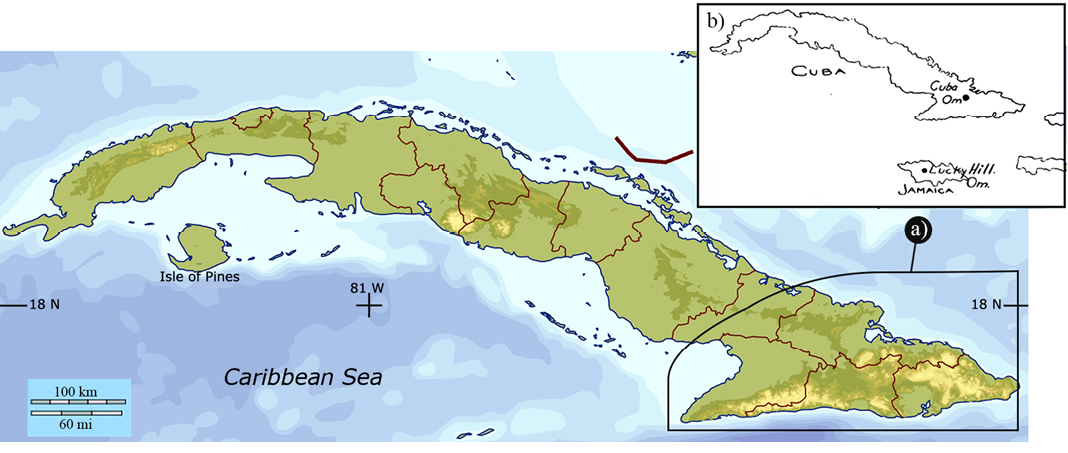
Figure. 2. General map of Cuba. The fall location of the meteorite “Cuba” a) is reported as the “Eastern Department” that includes the current provinces of Holguín, Guantánamo, Granma, and Santiago de Cuba. b) Fragment of the original map of Cuba and Jamaica extracted from Farrington (1909) with the probable location (black dot) of the meteorite “Cuba”, and the location of the historical iron meteorite Lucky Hill from Jamaica.
Solano y Eulate (1872) reported the Cuban specimen as found much before 1871, and later transferred to the meteorite collection of the National Museum of Natural Sciences in Madrid (MNCN), in Spain (Soto, 2018). According to the inventory of Muñoz-Espadas et al. (2002), the specimen is catalogued as No. 17294 and classified as a medium octahedrite (subtype IAB). Different weights have been reported for the specimen since Solano y Eulate (1872). The original publication provided a weight of 1327 g (at least 0.49 g was removed for chemical analysis), whereas subsequent works, however, have conflictingly indicated a weight variation of 1297 g, 1195 g, and 1200.6 g (Fernández-Navarro, 1923; King et al., 1986; Muñoz-Espadas et al., 2002). The specimen in the MNCN includes 10.4 g of dust material from the time it was analyzed, probably by Salvador Calderón around 1900. The different weights may represent the alteration and extraction of material for analysis. While some material was removed for chemical analysis in the past, the results of those analyses have been questioned (Buchwald, 1975) and this specimen has never been subjected to modern analysis techniques. Furthermore, the specimen was cut for research by NASA technicians in the 1960s, but the reports have never been located. Despite the historical significance of the Cuban specimen, the absence of a thorough and modern analysis leaves its true nature open to debate.
In this paper, scanning electron microscopy (SEM) and energy-dispersive X-ray spectroscopy (EDS) were applied to the fragment MNCN No. 17294 at MNCN to understand its chemical and textural properties.
MATERIALS AND METHODS
Material
Material studied in this paper included the MNCN No. 17294, USNM 2213, and the Me1087 specimens. The Madrid specimen MNCN No. 17294 (Figure 1) is housed in the meteorite collection of the National Museum of Natural Sciences (MNCN) in Madrid (Spain) as the main mass of the meteorite “Cuba”; whereas the USNM 2213 and the Me1087 specimens are housed in the meteorite collections of the Smithsonian National Museum of Natural History (USNM, Washington, US) and the Field Museum of Natural History (FMNH, Chicago, US) respectively. In addition, a rock specimen stored in the National Museum of Natural History of Havana (MNHNCu, Cuba), which had been previously misinterpreted as of meteoritic origin and collected from an archaeological site, was also studied for comparative purposes.
SEM-EDS measurements
The MNCN No. 17294 specimen was studied chemically and morphologically by Scanning Electron Microscopy (SEM) using the FEI InspectTM at the Scanning Electron Microscopy Laboratory of the MNCN. The unit incorporates a secondary electron detector (SE), backscatter electron detector (BSE), cathodoluminescence (CL) detector (Gatan MonoCL3 model), and Oxford Instruments INCA energy-dispersive X-ray spectrometer (EDS). EDS analysis was performed to measure the qualitative and semi-quantitative chemical compositions of the mineralogical phases of the specimen. Because the specimen was of historical significance, only the external surface was initially examined. The operating conditions were 30 kV accelerating voltage, 13.7 mm working distance, in low vacuum mode. Oxalic acid was applied to clean the specimen and for rust removal. Subsequently, a small fragment was cut to explore the nature of the internal matrix, and a new sample was prepared and studied through SEM. Also, an aliquot of MNCN No. 17294 was sent to the Chair of Metallurgy at the Technical School of Industrial Engineers in Madrid, who prepared and treated it with nitric acid and observed the surfaces under an electronic microscope.
For comparison, a SEM investigation of the MNHNCu specimen was performed using a JEOL JSM 5900LV microscope with EDS detectors, located at the Analytical Microscopy Laboratory of Florida International University, Miami, USA. The analyses had a resolution of up to 3 nm at multiple points.
RESULTS
In the initial exploration of MNCN No. 17294 through electron microscopy, eleven regions of interest were analyzed on the surface of one of the edges with a small polished, unetched area, and no traces of nickel were detected (Figure 3). The most significant element is iron (Tables 1 and 2), and there are also vesicles with oxygen and iron oxides. Iron oxide crystallization, resembling “hoppers”, are present in one of the images (Figures 3e–3f). The analyses revealed the presence of sulfur and silicium (Tables 1 and 2). Additional peaks of chlorine and carbon, which are likely natural, could also be the result of human manipulation. Contact of the specimen with organic materials might explain this type of surface contamination. This is a reminder of the care that must be taken when handling geological, especially meteoritical materials.
To gain further insights, a deeper investigation was conducted by performing a second SEM-EDS analysis on an aliquot of the same specimen. A polished section revealed internal vesicles containing iron oxide, and upon macroscopic examination, it showed numerous holes (Figure 4). Furthermore, EDS analysis showed that the specimen is chemically homogeneous as no detectable amounts of Ni were found in the interior, probably due to their extremely low concentration and spatial distribution. The EDS results (Figures 5 and 6) indicated a marked presence of Fe along with minor amounts of carbon (C), calcium (Ca), chlorine (Cl), oxygen (O), silicon (Si), and sulfur (S), while nickel (Ni) was undetectable.
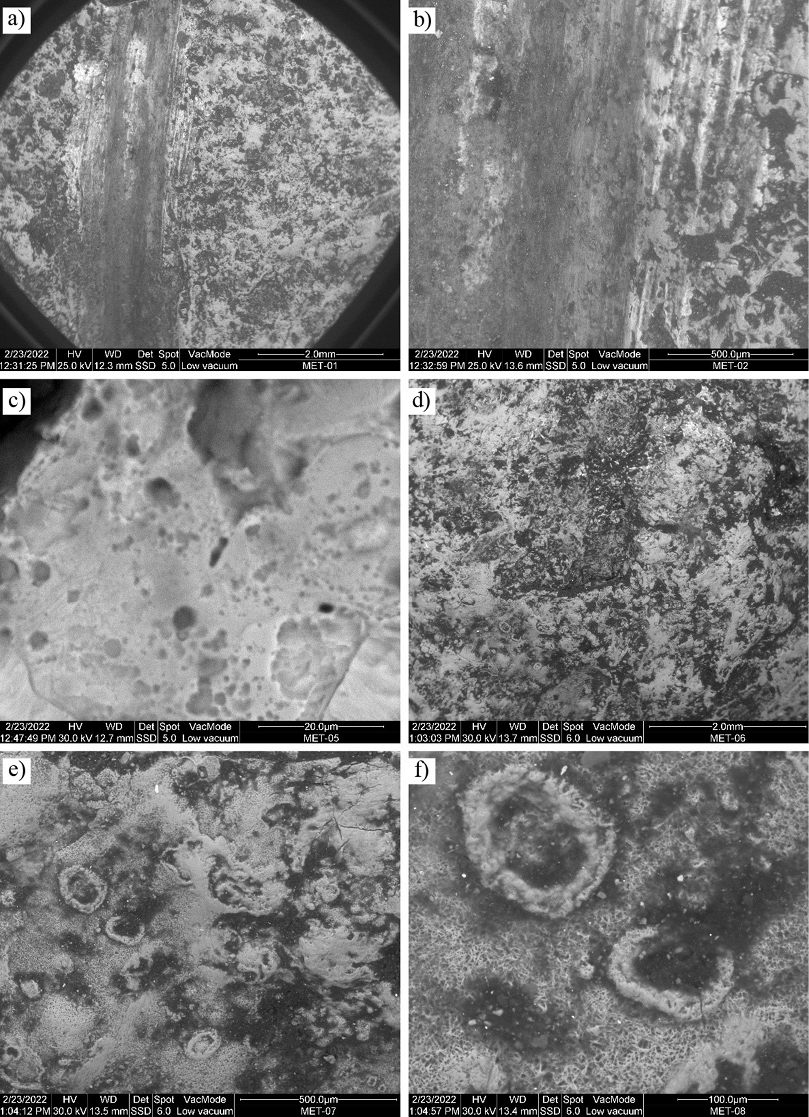
Figure 3. Backscattered electron images of six of the investigated regions on the surface of one of the edges with a small polished, unetched area, of MNCN No.17294. The images show the different compositions and microstructures, with brighter areas being richer in heavier elements, likely such as iron and silicon.
Table 1. Representative SEM-EDS compositions (wt%) for site of interest 1 of an aliquot of MNCN No.17294.
|
Element |
App Conc. |
Intensity Corrn. |
Weight % |
Weight % Sigma |
Atomic % |
|
O |
4.70 |
0.8620 |
23.62 |
2.00 |
46.50 |
|
Si |
2.14 |
0.6071 |
15.31 |
1.05 |
17.17 |
|
S |
0.39 |
0.7037 |
2.41 |
0.61 |
2.36 |
|
K |
0.28 |
1.0225 |
1.17 |
0.48 |
0.94 |
|
Ca |
0.64 |
1.0127 |
2.72 |
0.52 |
2.14 |
|
Fe |
11.55 |
0.9139 |
54.77 |
1.83 |
30.89 |
|
Totals |
100.00 |
Table 2. Representative SEM-EDS compositions (wt%) for site of interest 2 of an aliquot of MNCN No.17294.
|
Element |
App Conc. |
Intensity Corrn. |
Weight % |
Weight % Sigma |
Atomic % |
|
O |
3.52 |
1.0757 |
12.28 |
1.68 |
31.49 |
|
Si |
0.36 |
0.5278 |
2.56 |
0.64 |
3.74 |
|
Cl |
1.03 |
0.7269 |
5.31 |
0.69 |
6.14 |
|
Fe |
20.46 |
0.9619 |
79.85 |
1.76 |
58.64 |
|
Totals |
100.00 |
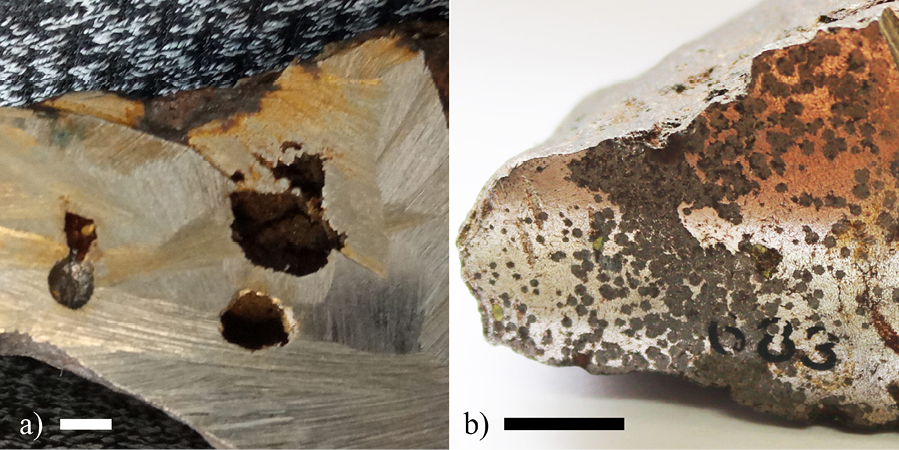
Figure 4. The Madrid specimen (MNCN No.17294). a) Close up of a fresh cut on the specimen showing holes. Scale = 0.5 cm. b) Old cut, probably treated, from previous investigations, to search for Widmanstätten pattern. Scale = 1 cm.
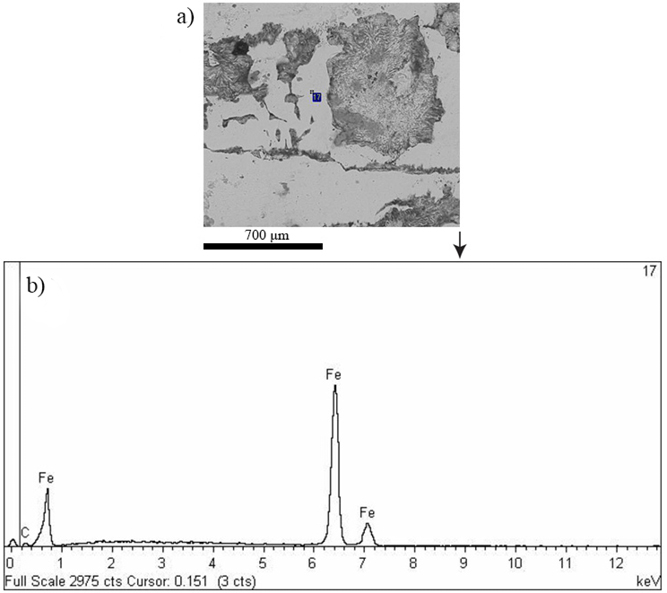
Figure 5. a) Backscattered electron image of one of the investigated areas of MNCN No.17294. b) EDS spectrum corresponding to a point of interest within the area of the sample, showing no detectable amounts of Ni.
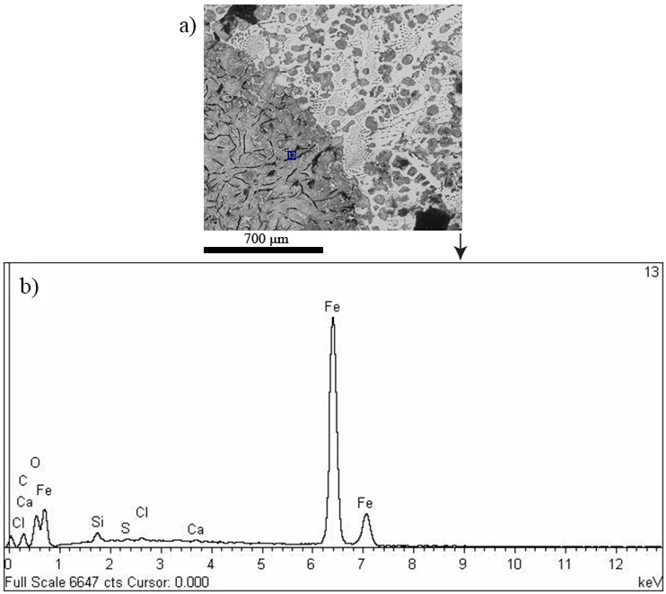
Figure 6. a) Backscattered electron image of one of the investigated areas of MNCN No.17294. b) EDS spectrum corresponding to a point of interest within the area of the sample, showing no detectable amounts of Ni.
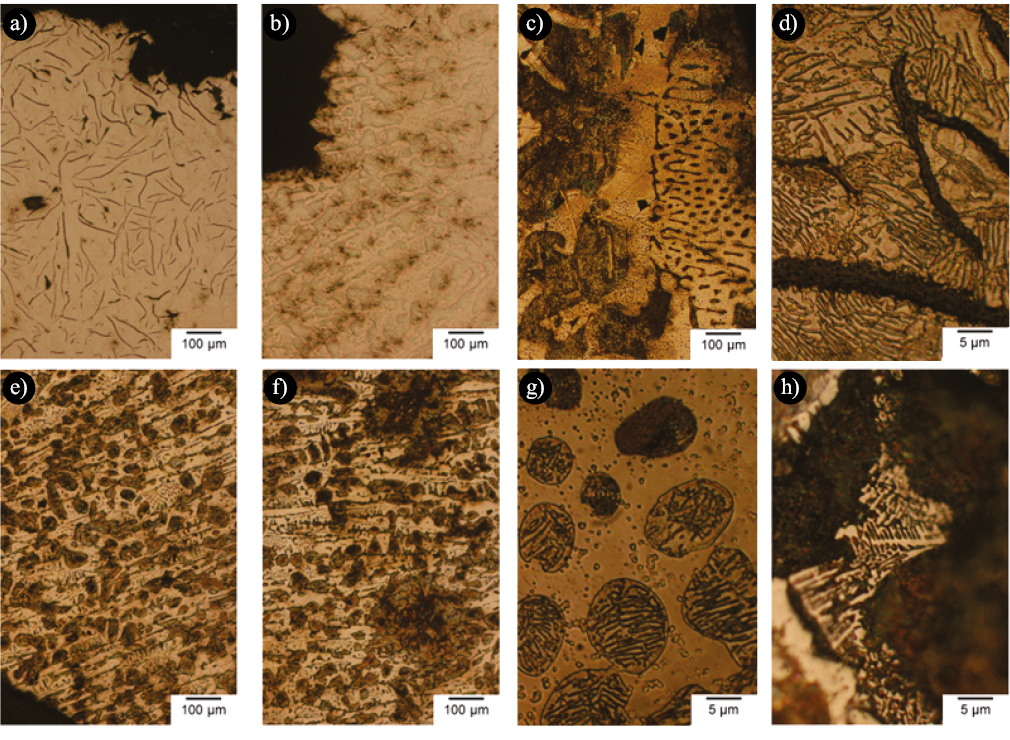
Figure 7. Optical microscopy images of an aliquot of MNCN No.17294, a–b) without treatment, c–h) with nitric acid treatment, showing dark-colored lines of a worm-like shape, likely attributable to graphite.
DISCUSSION
The “Cuba” specimen was originally reported to have an anomalously low nickel content of 3.24 % (Solano y Eulate, 1872), which deviates from the expected composition for iron meteorites (Scott, 2020). Buchwald (1975) suggested that the original analysis was inaccurate but did not provide a detailed explanation for that statement. The present microscopic investigations of MNCN No. 17294 (the Madrid specimen) using SEM and EDS confirmed the low nickel composition, supporting the assertion that this material is not of extraterrestrial origin.
It is worth noting that meteorites, especially iron meteorites, typically exhibit higher nickel content compared to our findings. Nickel content in artificial iron artifacts never exceeds 4 wt% (Tylecote, 1992). Based on the percentage of Ni in iron meteorites, they are classified into: hexahedrites with 5–6 % Ni, octahedrites with 6 %–17 % Ni, and ataxites with more than 17 % Ni (Krot et al., 2014; Bucurica et al., 2019). Octahedrites are the most common type of iron meteorite, showing a unique structure, called the Widmanstätten pattern (Krot et al., 2014; Scott, 2020). MNCN No. 17294 was previously identified as octahedrite (see Muñoz-Espadas et al., 2002) and Solano y Eulate (1872) mentioned the presence of Widmanstätten patterns on one of its polished facets after nitric acid treatment, indicating irregular circular figures formed by schreibersite nodules. Interestingly, the density was reported as
6.44 g/cm3 and the hardness as 6.9 Mohs scale (Solano y Eulate, 1872), which are values that do not correspond to an iron meteorite. To validate our previous results, an aliquot of MNCN No. 17294 was prepared, acid-treated, and observed under an optical microscope, with the main objective of revealing the Widmanstätten pattern; however, it did not display the pattern (Figure 7). Instead, it revealed areas corresponding to iron, and dark-colored lines of a worm-like shape, likely attributable to graphite (Figures 7b–7h).
The absence of detectable amounts of Ni in the EDS spectra, and the lack of Widmanstätten patterns, along with the presence of iron oxide, vesicles, holes, and the lower density compared to typical iron meteorites, supports the conclusion that the MNCN No. 17294 specimen is a terrestrial metallic object, likely an industrial slag. These findings underscore the necessity for further comprehensive investigations of the remaining specimens labelled as “Cuba” in other museums.
To compare the results, another iron-like metallic object (MNHNCu specimen) of 40.6 g was subjected to SEM-EDS analysis. This suspected meteorite (MNHNCu specimen) was found within an archaeological site from Cueva del Gato Jíbaro, Matanzas, western Cuba (Figure 8). The specimen was directly associated with an indigenous female burial (Mesolithic-hunter-gathered cultural affiliation) at this location, now dated to 1255-984 14C cal BP (Orihuela et al., 2020).
Initially, based only on visual inspection, the fragment was believed to be an iron meteorite, but its composition was unknown. However, the test results bore similarities to MNCN No. 17294, exhibiting a remarkably low nickel content (Figure 9, Table 3). Additionally, a cut made on the object surface failed to unveil the Widmanstätten pattern and instead displayed visible cavities within the polished section (Figure 8). Based on its EDS spectra, thin-section, low density (4.06 g/cm3) and other analyses, the MNHNCu specimen is now considered a hematite aggregate.

Figure 8. MNHNCu specimen from Cueva del Gato Jíbaro, Matanzas, western Cuba, believed to be meteoritic but resulted to be hematite aggregate. Scale = 1 cm.
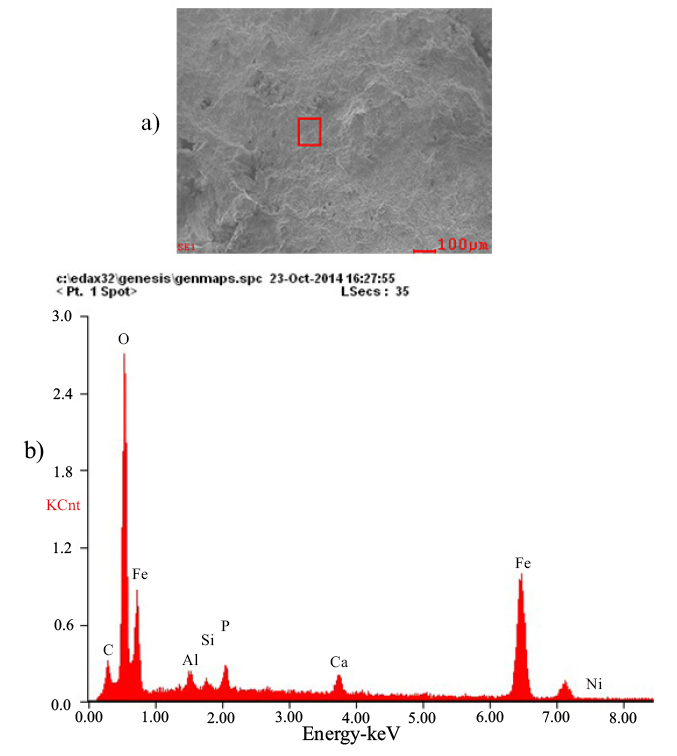
Figure 9. a) Backscattered electron image and b) EDS analysis spectra of the corresponding area in the MNHNCu specimen from Cueva del Gato Jíbaro, Matanzas, western Cuba. The EDS spectra show peaks for iron (Fe) with lower nickel (Ni) and aluminum (Al) contents. Note the incidence of phosphate-calcium peaks, both common aggregates of sedimentary rocks.
Table 3. Representative SEM-EDS compositions (wt%) for site of interest 1 of the MNHNCu specimen from Cueva del Gato Jíbaro, Matanzas, western Cuba.
|
Element |
Weight % |
Atomic % |
|
C |
10.53 |
23.47 |
|
O |
26.37 |
44.13 |
|
Al |
01.44 |
01.42 |
|
Si |
00.58 |
00.55 |
|
P |
01.84 |
01.59 |
|
Ca |
02.31 |
01.54 |
|
Fe |
56.62 |
27.15 |
|
Ni |
00.31 |
00.14 |
The Smithsonian and Chicago specimens
Ward (1904) reported 3 g of the “Cuba” material in his collection, which was later purchased by the FMNH, where it was characterized as “oxidized fragments (Me1087) of about 2.6 g” (Horback et al. 1965). More recently, Ceballos-Izquierdo et al. (2021) briefly described the specimen Me1087 as resembling an aggregate of iron-like oxides. Intriguingly, the material includes seven fragments, and according to Jim Holstein (pers. comm., 2023) only one is meteoritic. This result questions the real origin of the Me1087 specimens.
There is also genuine meteoritic material labelled as “Cuba” which was acquired in 1963 by the USNM. Buchwald (1975) characterized a 23 g slice in the USNM (No. 2213, 3 cm × 1.2 cm × 0.5 cm) as a medium to coarse octahedrite (kamacite lamellae have an average width of 1.30±0.30 mm) with a well-developed Widmanstätten pattern with oriented shine, common Neumann bands, no recrystallization, somewhat brecciated schreibersite but monocrystalline, and the total amount of phosphorus ranging from 0.2 to 0.3 %. The specimen was embedded in epoxy resin many years ago for preservation. Recent photographs show the highly polished metallic matrix now with a weak Widmanstätten pattern, filled with a scattered distribution of brown iron oxides, likely the result of weathering (Figure 10). The meteoritic nature of one fragment of Me1087 and the USNM No. 2213 specimen, contrasts with the Madrid material and makes it possible to confirm that they do not have the same origin. These findings add complexity to the investigation regarding the provenance and authenticity of the alleged Cuban meteorite from 1871. Therefore, the characterization of the “Cuba” rocks can be based only on the specimen in Madrid, which is not a meteorite.
There is a possibility that the USNM specimen may have been confused with other meteoritic material, as suggested by Buchwald (1975). The latter author hypothesized that this “Cuba” specimen might instead be part of the Toluca meteorite from Mexico, rather than an independent meteorite from Cuba. This hypothesis has never been conclusively proven. The provenance of the USNM specimen is poorly established and certainly, it is very similar to Toluca samples from Mexico, which pieces have been transported widely (Tim McCoy, pers. comm., 2019). If the USNM specimen is indeed part of the Toluca meteorite, it would not be an independent meteorite and should be reclassified accordingly. In the future, it will be necessary to carry out analyses to compare the chemical compositions of trace elements using less destructive techniques such as laser ablation-inductively coupled plasma-mass spectrometry (LA-ICP-MS) to evaluate the similarity between the sample USNM No. 2213, a fragment from Toluca, and one from Lucky Hill (another historic iron meteorite from the Caribbean). In the absence of better documentation of the finding of the USNM meteorite, definitive proof that it is from Cuba is uncertain.
Another possibility is that the original material of “Cuba” treasured in Madrid was meteoritic, and over the years it had been translocated by terrestrial material. But this hypothesis is highly improbable since the current specimen matches the original descriptions (Solano y Eulate, 1872; Gredilla, 1892a, 1892b; Farrington, 1909).
Importance of accuracy in the Meteoritical Database and official classification
Given the compelling evidence against the meteoritic origin of the Madrid specimen (MNCN No. 17294), as well as the uncertainties associated with the other masses currently identified under the “Cuba” label, it is recommendable to flag it as “doubtful iron” (https://www.lpi.usra.edu/meteor/metbullclass.php?sea=Doubtful+Iron). This step is essential to preserving the integrity and accuracy of the database, thus preventing confusion and the misallocation of resources. Excising the Cuban specimen from the section of official meteorites will ensure that researchers concentrate their efforts on genuine meteorites.
Concurrently, it is of utmost importance to pursue the official classification of the specimens known as Las Canas, Lajas, and Ramón de las Yaguas (Ceballos-Izquierdo et al., 2021). Formal recognition of these specimens will likely stimulate further research in the field of meteoritics, particularly within the Caribbean region. At the same time, a final note is necessary to make clear the information about some Cuban meteor-wrongs. Upon a thorough examination of these problematic materials (Ceballos-Izquierdo et al., 2021, and this paper), it becomes evident that these so-called meteorites (Mango Jobo, Boyeros, Güira de Melena, and Balcón de la Lisa) are, in fact, terrestrials or manmade objects. The visual appearance, internal cavities, and absence of typical meteoritic minerals in these rocks are not consistent with known properties of meteorites (Ceballos-Izquierdo et al., 2021). Additionally, another controversial specimen named Bacuranao, is also questionable as a meteorite, as the data provided on its original description does not support definitive conclusions (Segura-Soto, 1983). To maintain the integrity of the scientific information, it is crucial that these misidentified objects are definitively addressed as “meteor-wrongs” (Figure 11).
CONCLUSIONS
The inconsistencies in historical records, density, anomalous composition, and absence of the Widmanstätten pattern, collectively provide a strong case against the meteoritic nature of specimen MNCN No. 17294, historically regarded as the type mass of the meteorite “Cuba”. The application of modern analytical techniques, such as SEM and EDS, provided the necessary data to confirm the terrestrial nature of the “Cuba meteorite” stored in Madrid (MNCN No. 17294). It is strongly recommendable to flag it as “doubtful iron” in the Meteoritical Database. It is possible that the meteorite fragments referred as “Cuba” in the museums of Chicago and Washington D.C. do not belong to the original material stored in Madrid. Meanwhile, it is not possible to state with certainty if they were once part of an iron meteorite found on Cuba or were fragments taken from other meteorites.
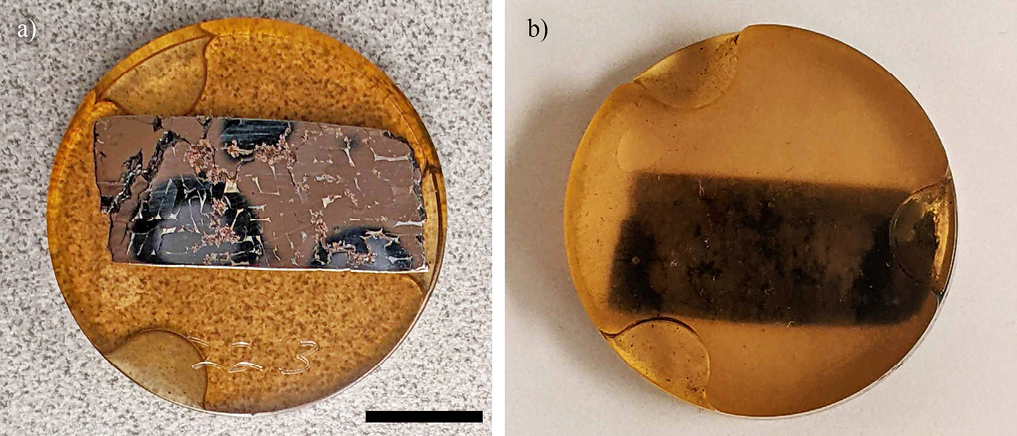
Figure 10. USNM No. 2213 a) Polished and etched slice showing a weak Widmanstätten pattern. b) –. Back side. Scale = 1 cm.
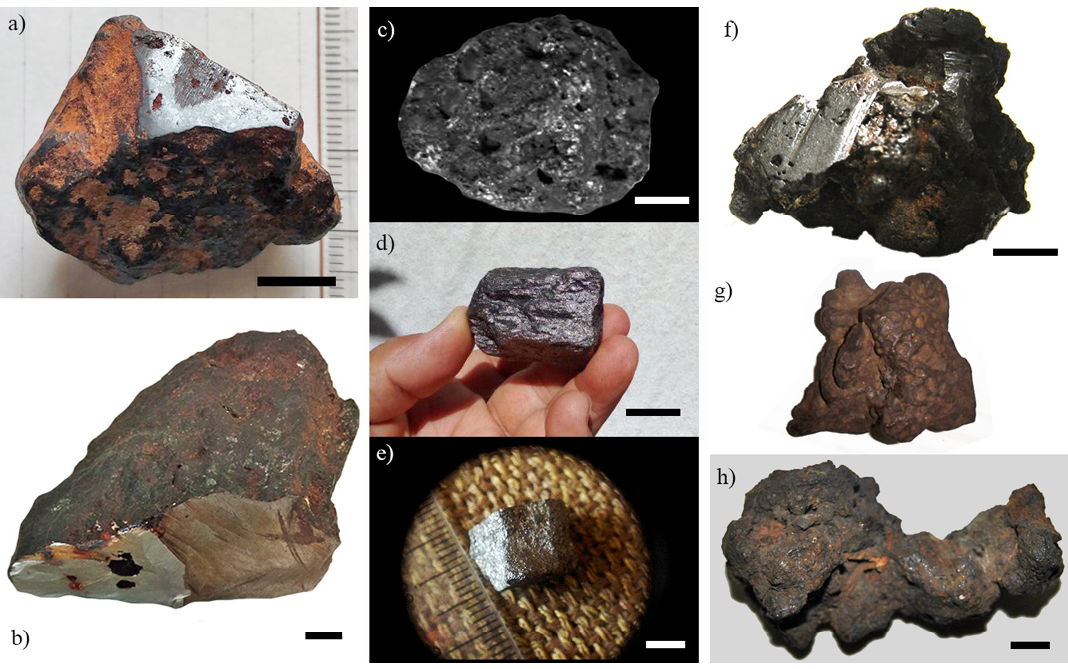
Figure. 11. Some Cuban meteor-wrongs updated from Ceballos-Izquierdo et al. (2021). a) Cueva del Gato Jíbaro, b) Cuba, c) Boyeros, d) Güira de Melena (Gámez), e) Balcón de La Lisa, f) Mango Jobo (larger fragment), g) Mango Jobo (medium fragment), h) Mango Jobo (smaller fragment). Scale = ~ 1 cm.
ACKNOWLEDGMENTS
We thank Tim McCoy (USNM), Philipp Heck (FMNH) and Jim Holstein (FMNH) who kindly provided photographs and information about the Cuban specimens deposited in their institutions. JO thanks Thomas H. Beasley of the Florida Center for Analytical Microscopy (FCAEM) at Florida International University (FIU) and Prof. Florentin J. M. Maurrasse of the Geosciences Department at FIU for access to their labs and guidance with SEM-EDS analyses. YCI thanks Joaquín A. Proenza (Universidad de Barcelona) and Gabriel Gongalvez (Instituto de Química, Universidad de São Paulo, Brazil) for a critical review of the manuscript. M. Iturralde-Vinent (ACC) encouraged the authors to perform this investigation and provided useful observations to the original manuscript. Comments from the editors, and the reviewers Idael F. Blanco-Quintero, and Gerardo J. Soto, were very helpful in improving the final version of the manuscript.
REFERENCES
Albina, G.K, 2021, Mineralogy and geochemistry of native iron. IOP Conference Series: Earth and Environmental Science, 906 (1), 012032, DOI: 10.1088/1755-1315/906/1/012032.
Benedix, G.K., Haack, H., McCoy, T.J., 2014, Iron and stony-iron meteorites, in Davis A.M. (ed.) Meteorites and cosmochemical processes, 2nd ed., Vol. 1, Treatise on Geochemistry: Oxford, Elsevier, 267-285.
Buchwald, V.F., 1975, Handbook of Iron Meteorites, Their History, Distribution, Composition and Structure: Berkeley, USA, University of California Press, 1418 pp.
Buchwald, V.F., 1977, The mineralogy of iron meteorites: Philosophical Transactions of the Royal Society of London, Series A, Mathematical and Physical Sciences, 286 (1336), 453-491.
Bucurica, I.A., Radulescu, C., Poinescu, A.A., Popescu, I., Dulama, I.D., Nicolescu, C. M., Murarescu, O., 2019, Morphology and Physico-Chemical Characteristics of an Iron Fragment from Chaco Province: Romanian Journal of Physics, 64, 906.
Ceballos-Izquierdo Y., Orihuela J., Goncalves G., Zurita M., Cardozo-Mourao D., Delgado-Manzor H., 2021, Meteorite and bright fireball records from Cuba: Mineralia Slovaca, 53(2), 131-145.
Farrington, O.C., 1909, Catalogue of the Meteorites of North America to January 1, 1909: Washington, DC, USA, Memoirs of the National Academy of Sciences, 13, 560 pp.
Fernández-Navarro, L., 1923, Los Meteoritos del Museo de Madrid: Boletín de la Real Sociedad Española de Historia Natural, 23, 224-233.
Gredilla, F., 1892a, Estudios sobre los meteoritos, Semanario farmacéutico, 20(44), 345-352.
Gredilla, F., 1892b, Estudios sobre los meteoritos. Semanario farmacéutico, Semanario farmacéutico, 20(54), 457-465.
Henderson, E.P., Perry, S.H., 1954. A discussion of the densities of iron meteorites: Geochimica et Cosmochimica Acta, 6 (5-6), 221-240.
Horback H., Hey M.H., Olsen E.J., Reinders, W., 1965, Catalog of the Collection of Meteorites in Chicago Natural History Museum: Fieldiana, Geology, 15(3), https://doi.org/10.5962/bhl.title.5157.
King, E.A., San Miguel, A., Casanova, I., Keil, K., 1986, Inventory of the meteorite collection of the Museo Nacional de Ciencias Naturales, C.S.I.C., Madrid, Spain: Meteoritics, 21(2), 193-197.
Krot, A.N., Keil, K., Scott, E.R.D., Goodrich, C.A., Weisberg, M.K., 2014, Classification of Meteorites and their genetic relationships, in Davis, A.M. (ed.), Meteorites and cosmochemical processes, 2nd ed., Vol. 1, Treatise on Geochemistry: Oxford, Elsevier, 1-63.
Muñoz-Espadas, M.J., Martínez-Frías, J., Lunar, R., Sánchez, B., Sánchez, J., 2002, The meteorite collection of the National Museum of Natural Sciences, Madrid, Spain: An updated catalog: Meteoritics & Planetary Science, 37, B1-B6.
Notkin, G., 2011, Meteorite hunting: How to find treasure from space: Tucson, USA, Aerolite Meteorites, 84 pp.
Orihuela, J., Viñola, L.W., Vázquez, O.J., Mychajliw, A.M., de Lara, O.H., Lorenzo, L., Soto-Centeno, J.A., 2020, Assessing the role of humans in Greater Antillean land vertebrate extinctions: New insights from Cuba: Quaternary Science Reviews, 249, p.106597.
Segura-Soto, R., 1983, Hallazgo de un meteorito en la Playa de Bacuranao, Cuba: Boletín de la Sociedad Cubana de Geología, 1(1), 76-82.
Scott, E.R., 2020, Iron meteorites: Composition, age, and origin: Oxford Research Encyclopedia of Planetary Science, https://doi.org/10.1093/acrefore/9780190647926.013.206.
Senesi, G.S., Manzari, P., Tempesta, G., Agrosì, G., Touchnt, A.A., Ibhi, A., De Pascale, O., 2018, Handheld laser induced breakdown spectroscopy instrumentation applied to the rapid discrimination between iron meteorites and meteor‐wrongs: Geostandards and Geoanalytical Research, 42(4), 607-614.
Solano y Eulate, J.M., 1872, Noticia sobre un hierro meteórico hallado en el departamento oriental de la isla de Cuba: Anales de la Sociedad Española de Historia Natural, Madrid, 1, 183-186.
Soto, G.J., 2018, La meteorítica en América Latina en el siglo XIX, in Morelos Rodríguez, L. Escamilla González, O., (coords.), 125 años de las meteoritas en el Palacio de Minería: Ciudad de México, México, Universidad Nacional Autónoma de México, 79-89.
Tylecote, F.A., 1992, History of Metallurgy: London, UK, The Institute of Materials, 205 pp.
Ward, H.A., 1904, Catalogue of the Ward-Coonley Collection of Meteorites: Chicago, Marsh, Aitken, and Curtis Company Printers, 120 pp. + 8 plates, available at: http://www.woreczko.pl/meteorites/references/ref_Catalogs/Ward-Coonley-1904.pdf.